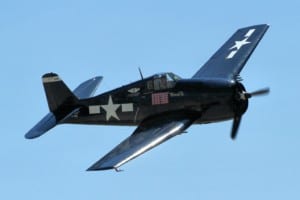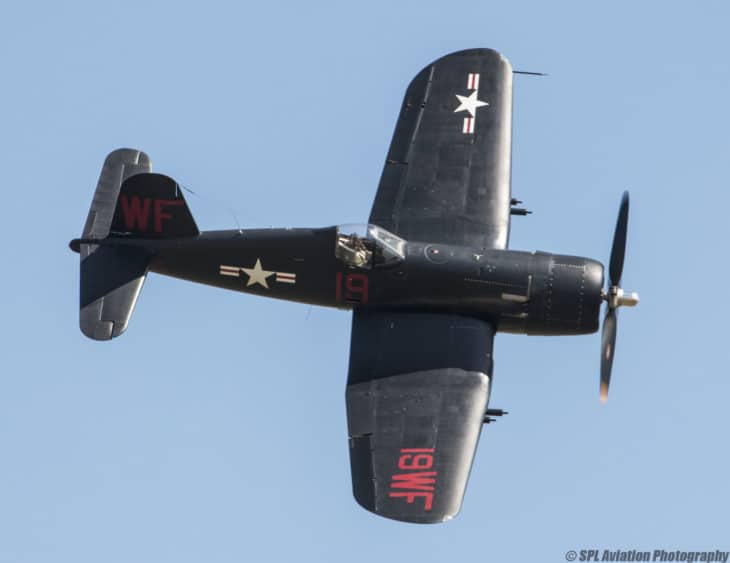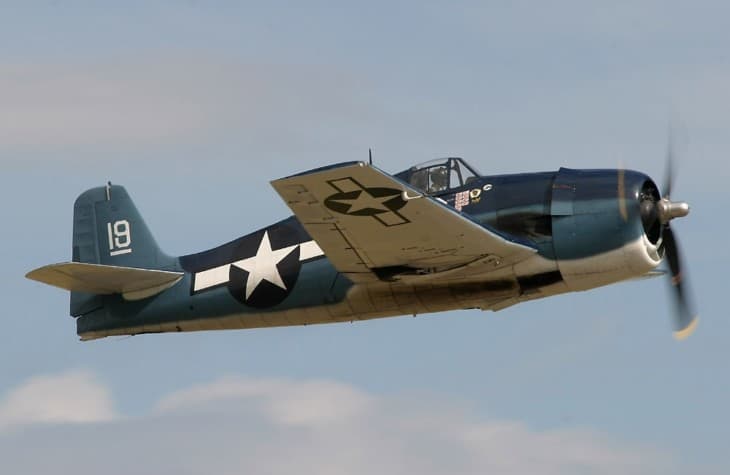Both saw action in World War II and have a loyal following of aviation enthusiasts. But F4U Corsair vs F6F Hellcat, which one is better? Let’s pit these two warbirds against each other and find out once and for all!
| Aircraft: | Vought F4U Corsair | Grumman F6F Hellcat |
|---|---|---|
| Photo: |
 |
 |
| Country: | United States | United States |
| Manufactured: | from: 1942 to: 1953 | from: 1942 to: 1945 |
| ICAO: | F4U | F6F |
| Price: | $ million | $0.035 million |
| Avionics: | - | AN/APS-4 Radar |
| Engine: | 1x Pratt & Whitney R-2800-18W Radial Engine | 1x Pratt & Whitney R-2800 Double Wasp |
| Engine Type: | other: Other | Piston |
| Power: | 2,400 horsepower | 2,000 horsepower |
| Max Cruise Speed: |
388 knots 719 Km/h |
340 knots 630 Km/h |
| Approach Speed (Vref): | 77 knots | 75 knots |
| Travel Range: |
880 Nautical Miles
1,630 Kilometers |
950 Nautical Miles
1,759 Kilometers |
| Fuel Economy: | - | - |
| Service Ceiling: | 41,500 feet | 37,000 feet |
| Rate of Climb: |
4360 feet / minute 22.15metre / second |
3650 feet / minute 18.54metre / second |
| Take Off Distance: |
220 metre 721.78 feet |
475 metre 1,558.38 feet |
| Landing Distance: |
232 metre 761.15 feet |
570 metre 1,870.06 feet |
| Max Take Off Weight: |
6,592 Kg 14,533 lbs |
6,992 Kg 15,415 lbs |
| Max Landing Weight: | - |
5,714 Kg 12,597 lbs |
| Max Payload: |
2,000 Kg 4,409 lbs |
1,800 Kg 3,968 lbs |
| Fuel Tank Capacity: |
534 gallon 2,021 litre |
250 gallon 946 litre |
| Baggage Volume: | - | - |
| Seats - Economy: | 1 seats | 1 seats |
| Seats - Business Class: | - | - |
| Seats - First Class: | - | - |
| Cabin Height: | - | - |
| Cabin Width: | - | - |
| Cabin Length: | - | - |
| Exterior Length: |
10.26 metre 33.66 feet |
10.24 metre 33.60 feet |
| Tail Height: | 4.5 metre - 14.76 feet | 3.99 metre - 13.09 feet |
| Fuselage Diameter: |
1.3 metre 4.27 feet |
1.5 metre 4.92 feet |
| Wing Span / Rotor Diameter: |
12.5 metre 41.01 feet |
13.06 metre 42.85 feet |
| Wing Tips: | No Winglets | No Winglets |
| More Info: | Vought F4U Corsair | Grumman F6F Hellcat |
|
Data presented is for entertainment purposes and should not be used operationally.
|
Other Vought F4U Corsair comparisons:
- F4U Corsair vs F8F Bearcat
- F4U Corsair vs Fw 190
- P-38 Lightning vs F4U Corsair
- P-51 Mustang vs F4U Corsair
- F4U Corsair vs Zero
- F4U Corsair vs MiG 15
Other Grumman F6F Hellcat comparisons:
The Vought F4U Corsair

The F4U Corsair was a groundbreaking American aircraft. It was designed and built for the specific purpose of air superiority during WWII. It was also one of the fastest and most maneuverable aircraft of its time.
The Corsair was loved by its pilots for its incredible speed and power, but it was also notoriously difficult to land on an aircraft carrier due to its long nose.
Why was it developed and built?
In 1940, the U.S. Navy released a request for a new fighter aircraft that could fly at 400 mph and have a range of 1,000 miles. At the time, no aircraft in existence could meet those specifications.
However, one company, Vought, believed they could develop an aircraft that would meet those requirements. And so the F4U Corsair was developed by Chance Vought and had one of the longest production runs of any piston-engined fighter in history.
What purpose did it serve?
The F4U saw action in several major battles during WWII, including the Battle of Midway, the Battle of Okinawa, and the Battle of Leyte Gulf. Its design and performance set it apart from other aircraft and helped ensure Allied victory in WWII. Most of all, it was also used by several militaries worldwide, including the navies of Australia, Canada, New Zealand, and France.
The Grumman F6F Hellcat

The F6F Hellcat was a carrier-based fighter aircraft that saw action in World War II.
It was significantly larger than the Corsair but was also faster and more heavily armed. Moreover, it was easier to land on an aircraft carrier than the Corsair due to its shorter nose, which made it a favorite among naval aviators.
Why was it developed and built?
The F6F Hellcat was one of the most important aircraft of World War II. Developed by Grumman Aircraft to replace the F4F Wildcat, the Hellcat was a much more capable fighter with better speed, range, and armament. It quickly became the mainstay of the U.S. Navy’s air power in the Pacific Theater.
What purpose did it serve?
The F6F Hellcat was one of America’s most successful aircraft designs of World War II. It quickly became the primary fighter of the U.S. Navy and Marine Corps in the Pacific Theater, seeing action in such famous battles as the Battle of Leyte Gulf and the Battle of Okinawa.
It demonstrated that American industry could produce an effective fighting machine to meet the challenges posed by Japan’s best fighters. The Hellcat also played a crucial role in turning the tide against Japan in the Pacific Theater. Today, the Hellcat is remembered as one of America’s finest achievements in aviation history.
How are the F4U Corsair and F6F Hellcat different?
The F4U Corsair and F6F Hellcat are World War II’s most iconic fighter aircraft. Though the Allies intensely utilized both during the conflict, several key differences exist between the F4U Corsair vs F6F Hellcat planes.
One of the most notable is their respective engines. The Corsair was outfitted with a powerful radial engine that gave it exceptional speed and maneuverability, while the Hellcat was equipped with a less powerful but more reliable inline engine.
This difference in engine design meant that the Corsair was better suited for dogfighting, while the Hellcat was better suited for long-range missions.
Another key difference is their armament. The Corsair was armed with four 20 mm cannons, while the Hellcat was armed with six .50 caliber machine guns. This gave the Hellcat a significant firepower advantage over its rival.
Finally, the two aircraft differed in their production timelines. The Corsair entered service in 1942, while the Hellcat didn’t see action until 1943. Though both aircraft were vital to the Allied victory in World War II, their different strengths and weaknesses meant they played complementary roles in the conflict.
How are the F4U Corsair and F6F Hellcat similar?
The F6F Hellcat and the F4U Corsair were both designed for one purpose: to take down enemy fighter planes. And they both excelled at their job.
- The Hellcat was faster, more maneuverable, and had a longer range than its predecessor, the F4F Wildcat.
- The Corsair, on the other hand, had a better rate of climb and could fly higher and faster than any other plane in U.S. naval history up to that point.
- It was also equipped with heavier armament than the Hellcat, making it a fearsome opponent in combat.
- The Corsair had slightly more kills than the Hellcat, but the Hellcat had a better kill-to-loss ratio.
These two planes were instrumental in helping the U.S. Navy win the war in the Pacific.
What’s better about the F4U Corsair?
The F4U had several innovative features that made it superior to other aircraft of its time. For example, it had a Pratt & Whitney R-2800 Double Wasp engine that gave it unmatched power.
Additionally, its gull-wing design allowed for shorter landing gear, which meant it could land and take off from shorter airstrips. In terms of armament, the F4U was also superior to other aircraft.
It was equipped with six .50-caliber machine guns and bombs, and rockets. This made it a formidable opponent in combat.
What’s better about the F6F Hellcat similar?
The F6F Hellcat was an impressive feat of engineering developed during WWII to knock out Japanese Fighters like none other before it. Not only did she have beauty, but she packed one helluva punch too!
With 12k+ units made, this workhorse was responsible for taking down over 5223 enemy aircraft while serving the U.S.! Do you know how long a plane lasts and why old warplanes have targets on them?
Conclusion
So, which one is better? It depends! Both the Corsair and Hellcat were excellent fighter aircraft in their own right. If we had to choose one, we would go with the Hellcat simply because it was slightly faster and easier to land on an aircraft carrier. However, both have unique strengths and weaknesses, so it comes down to preference.


